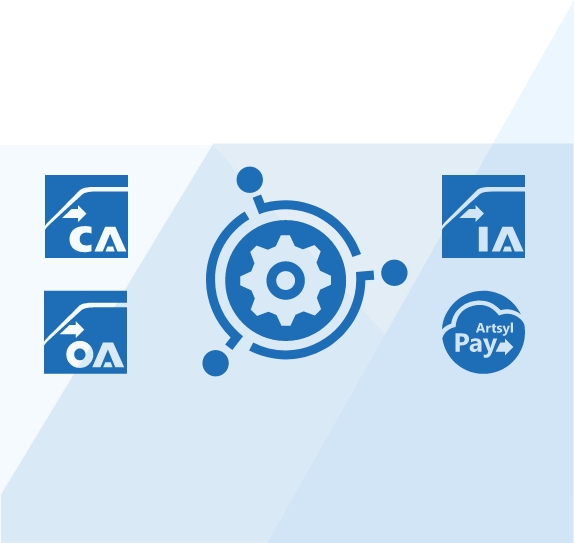In today’s era, businesses gather massive amounts of data from various sources, such as feedback forms, invoices, receipts, and other documents. Extracting data from these sources manually can be overwhelming for businesses, consuming a significant amount of time.
Manual data extraction can lead to errors, inconsistencies and result in data being input into different systems multiple times. Technological advancements have paved the way for businesses to extract data efficiently and accurately through Optical Character Recognition (OCR). In this blog, we will discuss data extraction with OCR, its benefits for businesses, and how it can be implemented in daily operations.

Discover the power of OCR data extraction with Artsyl!
Unlock the potential of AP automation and streamline data extraction from invoices with our advanced OCR technology.
What is Data Extraction?
Data extraction is the process of extracting information from unstructured data sources such as forms, invoices, receipts, surveys, and emails, to name a few.
Data extraction enables businesses to turn unstructured data into usable formats that can be used for analytics, decision-making, and other purposes. Data extraction usually involves identifying relevant data points from a document and using an algorithm to transform that data into structured data that can be easily analyzed.
Intelligent Process Automation Solution
Related Videos
What is OCR in the Context of Data Extraction?
Optical Character Recognition (OCR) is software that converts handwritten or printed text into machine-readable text. OCR uses image processing techniques to identify and extract text from scanned images, photographs, and other digital formats and then converts that text into a digital format.
OCR, or Optical Character Recognition, in the context of data extraction, refers to the technology and process of converting printed or handwritten text from physical or digital documents into machine-readable and editable data. It involves using advanced algorithms and techniques to analyze and recognize characters, words, and other textual elements in documents, enabling automated extraction and processing of data.
OCR plays a crucial role in data extraction by converting unstructured or semi-structured data from documents, such as invoices, receipts, forms, contracts, and reports, into structured and searchable digital formats. It eliminates the need for manual data entry, saving time and reducing errors associated with manual transcription.
OCR in data extraction enables businesses to automate converting diverse and often unstructured data from documents into usable and structured digital formats. This way, OCR data extraction improves data accuracy, saves time, and facilitates efficient data analysis, reporting, and decision-making processes.
Effortless and integrated OCR data extraction starts with Artsyl! Experience the speed and accuracy of OCR data extraction from orders built into our cutting-edge document processing platform.
Get started today!
Book a demo now
The Basics of PDF OCR Data Extraction
This process of extracting textual data from PDF (Portable Document Format) files uses Optical Character Recognition (OCR) technology. PDF is a widely used file format for documents that preserves the layout and formatting across different devices and platforms.
OCR technology converts scanned or image-based PDF files into editable and searchable text. It recognizes and interprets the characters within the PDF document, making it possible to extract the textual content for further analysis, manipulation, or storage.
PDF OCR data extraction is beneficial when dealing with PDF files that are not text-selectable or editable by default. It allows you to unlock the information in these files and convert them into machine-readable and searchable formats.
By applying OCR to PDF files, you can extract data from invoices, receipts, reports, contracts, or any other document in PDF format. This extracted data can be used for various purposes, such as analysis, data entry automation, information retrieval, or integration with other systems.
Overall, PDF OCR data extraction enhances the accessibility, usability, and efficiency of PDF documents by transforming them into editable and searchable text, opening up a range of possibilities for data utilization and management.
OCR Data Extraction from Invoices: Step by Step
OCR data extraction from invoices involves using Optical Character Recognition (OCR) technology to extract relevant information from invoice documents. Here’s a general overview of how the process works:
- Scanning or uploading: The invoices are scanned or digitally uploaded into an OCR system. The system can handle various file formats, including PDFs, scanned images, and photographs.
- Image pre-processing: The OCR system applies pre-processing techniques to enhance the quality and clarity of invoice images. This may involve tasks such as noise reduction, image rotation, or contrast adjustment to improve OCR accuracy.
- Text recognition: The OCR technology analyzes invoice images and identifies their text elements. It recognizes characters and words by analyzing their patterns, shapes, and other features.
- Optical character recognition: The system applies optical character recognition algorithms to convert the recognized text elements into machine-readable and editable formats. It accurately recognizes and converts the text from the invoice image into digital text data.
- Data extraction: The OCR system uses predefined rules or templates to locate and extract specific fields from the invoice, such as invoice number, date, supplier information, line items, totals, and other relevant details. These rules or templates can be customized to match the layout and structure of different invoice formats.
- Data validation and verification: The extracted data is validated and verified against predefined criteria or business rules to ensure accuracy and consistency. This may involve cross-checking data against existing databases, performing calculations, or applying validation rules to detect potential errors or discrepancies.
- Exporting and integration: The extracted invoice data is then exported in a structured format, such as CSV, XML, or JSON, for further processing or integration with other systems. Thanks to intelligent process automation by Artsyl, it can be seamlessly integrated into accounting software, enterprise resource planning (ERP) systems, or other business applications for streamlined invoice processing and automation.
OCR data extraction from invoices offers significant time savings and accuracy improvements compared to manual data entry. It enables the efficient processing of large volumes of invoices, reduces human errors, and provides businesses with valuable insights from the extracted data for financial analysis, reporting, and decision-making.
Save time and improve the accuracy and compliance of your invoices with OCR. Harness the power of OCR data extraction by Artsyl and ditch manual data entry as you unlock the efficiency of automated invoice processing.
Book a demo now
Data OCR Extraction from Forms
Data OCR extraction from forms refers to the very useful process of using Optical Character Recognition (OCR) technology to extract data from structured forms. These forms can include:
- Surveys
- Questionnaires
- Application forms
- Feedback forms
- Medical claim forms
- Any other document that collects information in a standardized format.
The OCR extraction process from forms typically involves the following steps:
- The forms are scanned using a physical scanner or uploaded into an OCR system as digital files.
- Like other OCR data extraction processes, the form images undergo pre-processing techniques such as image enhancement, noise reduction, or contrast adjustment to optimize the images for accurate OCR recognition.
- The OCR data extraction system identifies and recognizes the structure of the form, including fields, labels, checkboxes, and other form elements. This step involves analyzing the form layout and understanding the position and types of fields.
- The OCR technology analyzes the form’s text fields and extracts the textual data within each field. It recognizes characters, words, or numbers based on their shapes, patterns, and context.
- The extracted text data is mapped to the corresponding fields or zones in the form structure. The OCR system uses predefined rules, templates, or machine learning algorithms to extract data accurately from each field.
- Data extracted from forms undergoes validation against predefined criteria or business rules to ensure accuracy and consistency. This step may involve data formatting, correcting errors, or validating data based on specific constraints.
- OCR-extracted data is exported in a structured format, such as CSV, XML, or JSON, for further processing, analysis, or integration with other systems or databases.
OCR extraction from forms streamlines the data capture process by automating the conversion of structured form data into digital format. It eliminates manual data entry, reduces errors, and enables faster processing and analysis of form responses.
No wonder OCR data extraction technology is widely used in industries such as finance, healthcare, market research, and customer surveys, where large volumes of form data need to be processed accurately and efficiently.
Can I Use OCR Data Extraction from Receipts?
Yes, OCR data extraction can be used for extracting information from receipts. Receipts often contain important data such as vendor names, dates, amounts, item descriptions, and other transaction details. OCR data extraction technology can be applied to recognize and extract this textual information from receipts’ scanned or digital images.
The OCR data extraction technology analyzes the receipt images and identifies the text elements present, such as merchant names, dates, amounts, and item details. It recognizes the characters, words, and numbers based on their visual patterns and context. The OCR system then uses predefined rules or machine learning algorithms to locate and extract specific fields of interest, such as total amounts or itemized details.
Using OCR for receipt data extraction can significantly automate and streamline the process of capturing and digitizing receipt information. It eliminates the need for manual data entry, saves time, reduces errors, and facilitates efficient expense tracking, financial analysis, or compliance purposes.
OCR data extraction from receipts technology has been widely adopted in various industries, including retail, finance, and expense management, to improve the efficiency and accuracy of receipt data processing.
Supercharge your document workflow! Explore OCR order data extraction by Artsyl, and revolutionize how you handle your sales orders. Empower your business with intelligent automation.
See the difference now!
Book a demo now
OCR Zone Data Extraction: How it Helps?
OCR can accurately recognize and extract characters from various languages and fonts, making it an ideal solution for businesses with documents in multiple languages.
OCR zone data extraction refers to extracting specific information from designated zones or regions within a document using Optical Character Recognition (OCR) technology. In OCR zone data extraction, specific areas or zones of a document, such as fields, tables, or sections, are identified and extracted for further processing. These zones are predefined based on the structure or layout of the document.
OCR algorithms analyze the text within these zones and convert it into digital data that can be used for various purposes, such as data entry, document indexing, or information retrieval.
This technique is commonly used in document automation and data capture applications where structured data needs to be extracted from semi-structured or unstructured documents, such as invoices, forms, or contracts.
By defining OCR zones and extracting relevant data from specific areas of the document, OCR zone data extraction streamlines the data extraction process, improves accuracy, and reduces manual effort in data entry tasks.
Benefits of Data Extraction and OCR for Businesses
Adopting data extraction and OCR technologies can benefit businesses in various ways. Firstly, these technologies can reduce the time and effort it takes to extract data from documents manually. Businesses can focus on core activities without sacrificing accuracy or speed by automating the data extraction.
Secondly, data extraction and OCR can improve the accuracy and quality of the extracted data. With automated processes in place, the risk of human error decreases, and businesses can have more confidence in the data they are working with.
Thirdly, businesses can use advanced analytics and machine learning algorithms to derive previously unattainable insights by converting unstructured data into a structured format.
Implementing Data Extraction OCR in Business Operations
Implementing data extraction OCR in business operations requires careful consideration of the needs of the business in terms of scale, complexity, and costs.
Implementing the technology in a large enterprise can require more significant investment due to the need for custom integrations to existing systems. Conversely, small and medium-sized enterprises might be able to adopt these technologies with turnkey solutions readily available in the market.
Prioritizing the data sources that bring the most value to the business can help businesses maximize the benefits of data extraction and OCR technology.
Unleash the potential of your business documents: Artsyl’s OCR data extraction technology empowers you to unlock valuable insights hidden within your invoices. Take control of your data and explore the possibilities of InvoiceAction!
Book a demo now
Final Thoughts
Data extraction OCR technology can benefit businesses by automating manual data capture processes, making data extraction faster and more accurate, and allowing businesses to extract more insights from their data.
Businesses should carefully evaluate their needs and the data sources that provide the most value to them to get the best results. In conclusion, data extraction and OCR technology can improve ROI and provide value to businesses by reducing time and enhancing accuracy and quality.




 OCR Image to Text Conversion: What is It?
OCR Image to Text Conversion: What is It? PDF OCR Conversion: Step-by-Step
PDF OCR Conversion: Step-by-Step How to Use OCR Software for PDFs and Other File Formats
How to Use OCR Software for PDFs and Other File Formats OCR: What Optical Character Recognition Is?
OCR: What Optical Character Recognition Is? Exploring the Benefits of OCR Technology Across Diverse Business Processes
Exploring the Benefits of OCR Technology Across Diverse Business Processes Document OCR – Simplifying Work Processes
Document OCR – Simplifying Work Processes